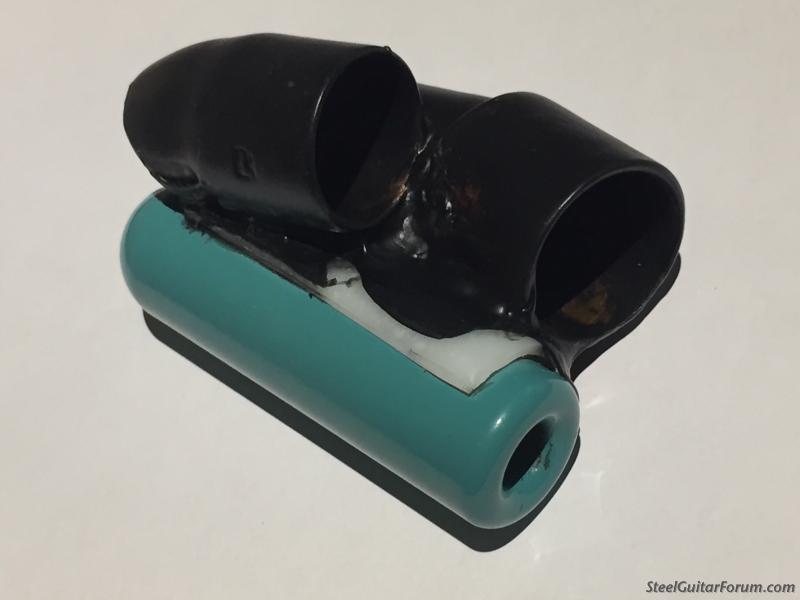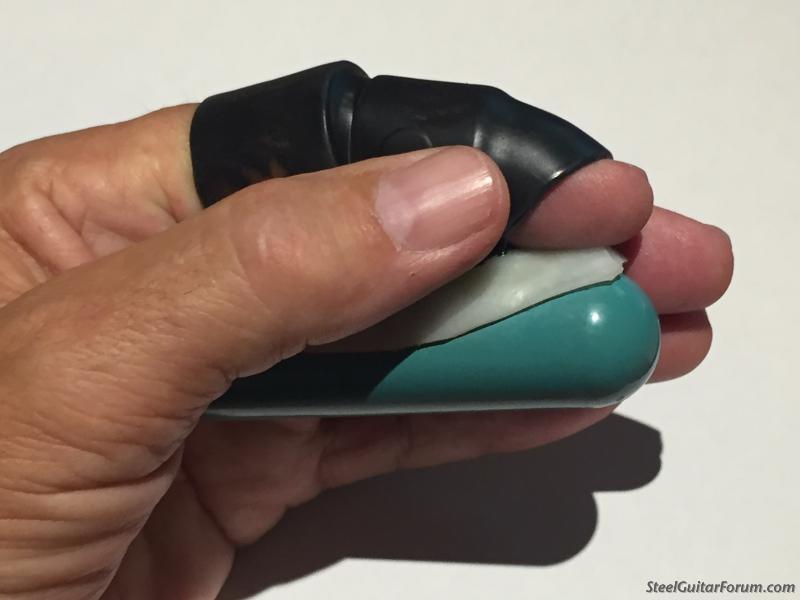| Author |
Topic: Suggestions for a Disabled Player |
Kenny Davis
From:
Great State of Oklahoma
|
 Posted 31 Oct 2018 8:54 pm
Posted 31 Oct 2018 8:54 pm |
|
My friend Carroll Benoit has asked me to post this to get some ideas for helping a friend of his.
As most of you know, Carroll is not one to turn his back on a challenge when it comes to building instruments. Besides all of the amazing work he did for HowardR and others, you may not know about the beautiful Harpsichord he finished last year! You may also remember the resonator he modified for Chuck in California who suffered from severe limitations to his arms and hands.
A good friend of Carroll recently had a terrible accident that cost him his left arm. Prior to the accident he was an accomplished guitar player. He thought his playing days were over until Carroll provided him with a resonator guitar to see if he could possibly make music with it. Holding the bar with his split hook, he was able to navigate but was limited to deliberate and somewhat awkward moves due to angle and the way the bar was located.
Carroll wants to know if anyone has any advice on improving the angle or placement of the bar on the prosthetic, and hoping someone with a machining background would be able to help him. The prosthetic doesn't appear to be of the type that actually looks and operates like a real limb.
He looks in on The Forum, and will respond to anyone that might be able to help.
Thanks in advance - |
|
|
 |
David M Brown
From:
California, USA
|
 Posted 1 Nov 2018 6:06 am
Posted 1 Nov 2018 6:06 am |
|
First, I'm sorry for the player in question; next, I'd suggest some sort of arrangement similar to what Billy Hew Len used to hold the bar on his traumatically amputated left wrist.
Here are some pics and a video.
https://www.youtube.com/watch?v=6IrSq1rOoL4




I hope this offers some help. |
|
|
 |
Nic Neufeld
From:
Kansas City, Missouri
|
 Posted 2 Nov 2018 3:06 am
Posted 2 Nov 2018 3:06 am |
|
The example of Billy Hew Len is about as good of one as you could have...not only did he learn to play well, he became one of the very best!
I'm not an expert but I think he had leather worked into the design...possibly used to damp and mute strings?
_________________
Waikīkī, at night when the shadows are falling
I hear the rolling surf calling
Calling and calling to me |
|
|
 |
David Matzenik
From:
Cairns, on the Coral Sea
|
 Posted 2 Nov 2018 5:31 am
Posted 2 Nov 2018 5:31 am |
|
Look, I know this might sound like sacrilege, but I am thinking pedal steel could be a better choice, as the the bar is generally parallel to the frets, and a lot of work is done with the feet.
_________________
Don't go in the water after lunch. You'll get a cramp and drown. - Mother. |
|
|
 |
Bill Groner
From:
QUAKERTOWN, PA
|
 Posted 2 Nov 2018 6:31 am
Posted 2 Nov 2018 6:31 am |
|
So exactly what instrument are we talking about playing? Reso, lap steel, pedal steel. Would a polymer bar work OK on a Reso Guitar?
_________________
Currently own, 6 Groner-tone lap steels, one 1953 Alamo Lap steel, Roland Cube, Fender Champion 40 |
|
|
 |
Roy Thomson
From:
Wolfville, Nova Scotia,Canada
|
 Posted 2 Nov 2018 6:34 am
Posted 2 Nov 2018 6:34 am |
|
One idea that comes to mind is to have a floating Steel Bar over the Fret Board. Spring Loaded so that it could be moved and pushed down on the strings. You would need a felt mute that would contact the strings just ahead of the Steel which would substitute for blocking. The split hook of course would be connected in some fashion to the Steel Bar to move it and push it down.
The bar would be moved as required along a spring loaded track so that when pushed down it would come back up and ready for the next move.
It would take some design engineering but I believe it could be done.
Feasible ??
I wish Carroll's friend all the best and hope he finds a way to play again.
_________________
Custom Tabs Various Tunings
Courses Lap Steel, Pedal Steel |
|
|
 |
David M Brown
From:
California, USA
|
 Posted 2 Nov 2018 7:29 am
Posted 2 Nov 2018 7:29 am |
|
| Nic Neufeld wrote: |
The example of Billy Hew Len is about as good of one as you could have...not only did he learn to play well, he became one of the very best!
I'm not an expert but I think he had leather worked into the design...possibly used to damp and mute strings? |
Yes the "glove" was made of leather as far as I know.
| Roy Thomson wrote: |
| One idea that comes to mind is to have a floating Steel Bar over the Fret Board. Spring Loaded so that it could be moved and pushed down on the strings. You would need a felt mute that would contact the strings just ahead of the Steel which would substitute for blocking |
That reminds me of one of those Depression-era "patent" instruments sold door-to-door:
https://en.wikipedia.org/wiki/Tremoloa

It has a bar on a arm much as you describe. |
|
|
 |
David Mason
From:
Cambridge, MD, USA
|
 Posted 3 Nov 2018 12:12 am
Posted 3 Nov 2018 12:12 am |
|
| Can he change the angle of a steel? I don't mean slants but holding the bar vertically, say 90 degrees angle from the strings, and then tilt it back a bit? I'm envisioning a doohickee with an H-shape cross-section, the front leg of the "H" being a smooth surface that slickly meets the strings, and the back leg then squishing with a softer foam mute. Or, like a half-tube with a 0.75" radius steel facing, with only steel contacting strings when vertical, transitioning to a... foam? leather? face. This stuff is kind of a point of pride for quippies like Ian McWee at Diamond Bottlenecks, and builders too, notably Gene Fields at GFI. I unfortunately KNOW it's past melodrama to say that music may be just about the only thing left for some. |
|
|
 |
Bill Burch
From:
California, USA
|
 Posted 4 Nov 2018 9:57 pm
Posted 4 Nov 2018 9:57 pm |
|
This excerpt is from an earlier thread I started on making some sort of device to enable my nerve-damaged fingers to manipulate the bar. What I discovered is you have to get the hand/fingers as close to bar as possible This gives the most control. It's working quite well for me.
Tell your friend we all admire his courage and wish him success.
Bill
| Bill Burch wrote: |
Progress! After crafting a couple of options including the wrist-mounted bar and a palm device, I think I've come up with something workable. Anchoring my fingers in as much as a standard playing position was going to be the best solution. I also needed some additional weight to replace the downward pressure my fingers weren't providing.
I found some copper fittings at the hardware store and fashioned segments that fit my first and second fingers. JB Weld 2-part steel epoxy held the sections together. I then epoxied the metal "fingers" to a mountain strip of InstaMorph shapeable plastic, arched to fit my 7/8" bar.
Finally, I dipped the finger sections into Plasti Dip to give a good gripping surface .
This is going to work. I can see the bar tip for intonation and the hand position is where it should be. My hope is that my condition is temporary and soon i can dispense with the prosthetic bar and just get back to learning. But in the meantime, I have a work-around.
Bill



 |
|
|
|
 |
Kenny Davis
From:
Great State of Oklahoma
|
 Posted 11 Dec 2018 8:26 pm ***UPDATE*** Suggestions for a Disabled Player
Posted 11 Dec 2018 8:26 pm ***UPDATE*** Suggestions for a Disabled Player |
|
I'm happy to report someone has answered the call to help Carroll Benoit's friend overcome a major hurdle in playing his resonator guitar.
Within a few days a Forum member contacted Carroll to further discuss the situation. Within a short time, he designed and machined a device that would attach to the artificial limb in a more natural angle that enables him to accurately place the bar up and down the neck. He also made a provision to attach a dampener similar to what is seen in the Billy Hew Len photos and video. I've included a couple of photos of the device -


On behalf of Carroll and his friend David, we want to thank this special talented person for his interest in making this happen! The photo below speaks for itself!
 |
|
|
 |
Paul Honeycutt
From:
Colorado, USA
|
 Posted 11 Dec 2018 8:53 pm
Posted 11 Dec 2018 8:53 pm |
|
That's great. I'm an amputee (left leg) myself and it's good to see folks finding solutions for problems like this. I have both arms and hands, so I feel pretty blessed that I can still play. Pedal steel is out, however, but that's OK, I never wanted to play one.  |
|
|
 |
David M Brown
From:
California, USA
|
 Posted 12 Dec 2018 5:21 am
Posted 12 Dec 2018 5:21 am |
|
| I wish all the best to a courageous man. |
|
|
 |
Jim Newberry
From:
Seattle, Upper Left America
|
 Posted 12 Dec 2018 12:09 pm
Posted 12 Dec 2018 12:09 pm |
|
Wow, that's a great story! All the best to David...
_________________
"The Masher of Touch and Tone"
-1950 Fender Dual Pro 8
-1950's Fender Dual Pro 6
-Clinesmith D8
-Clinesmith 8-string Frypan
-Clinesmith Joaquin
-~1940 National New Yorker
-~1936 Rickenbacher B6
-Homebuilt Amps |
|
|
 |




